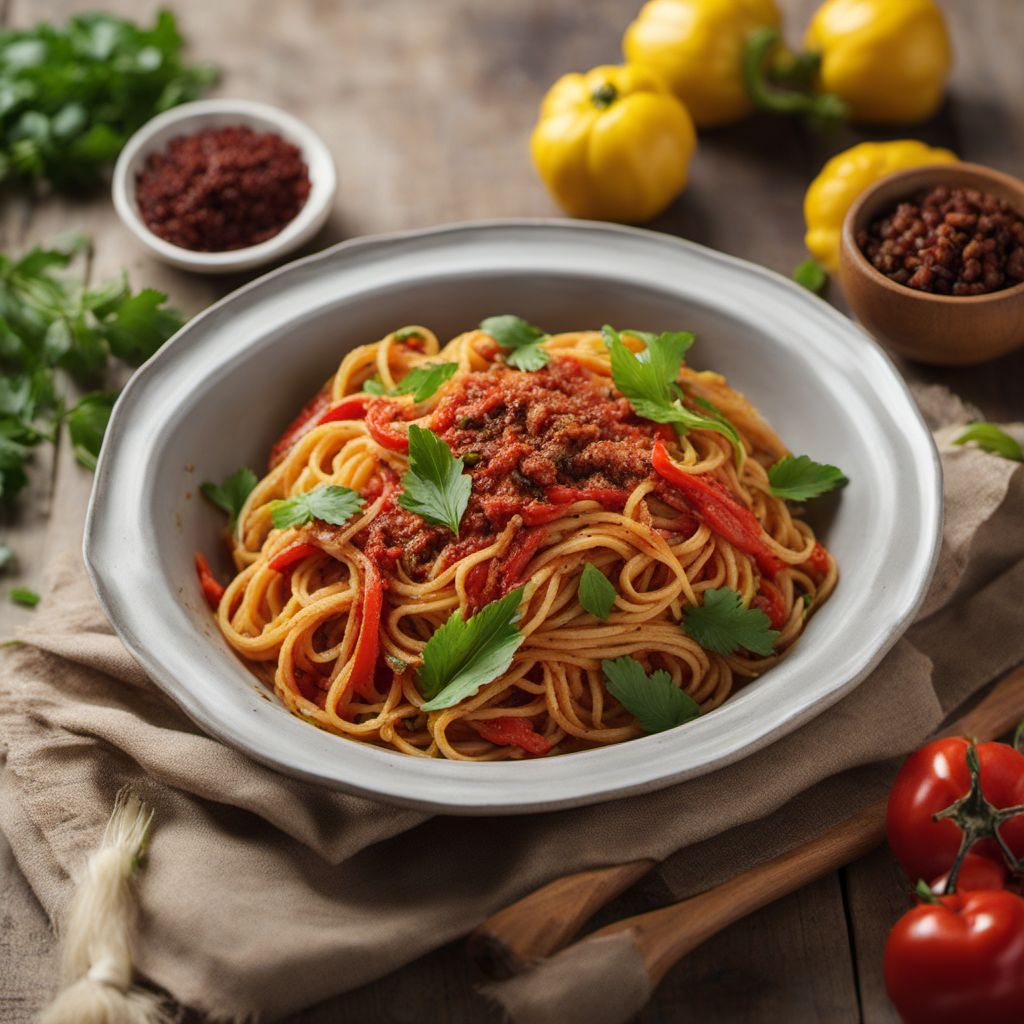
Recipe
Palestinian-style Naporitan Pasta
Flavors of Palestine: A Fusion of Japanese Naporitan and Palestinian Cuisine
4.8 out of 5
Indulge in the delightful fusion of Japanese and Palestinian cuisines with this Palestinian-style Naporitan Pasta recipe. Combining the vibrant flavors of the Middle East with the beloved Japanese pasta dish, this recipe offers a unique and delicious culinary experience.
Metadata
Preparation time
20 minutes
Cooking time
25 minutes
Total time
45 minutes
Yields
4 servings
Preparation difficulty
Easy
Suitable for
Vegetarian, Vegan (omit garnish), Dairy-free, Nut-free, Soy-free
Allergens
Wheat
Not suitable for
Gluten-free (unless using gluten-free pasta)
Ingredients
In this Palestinian adaptation of Naporitan, we incorporate traditional Palestinian spices and flavors to create a unique fusion dish. The original Japanese Naporitan typically includes ingredients like ketchup, Worcestershire sauce, and sausage, which we replace with Palestinian spices, caramelized onions, and bell peppers to infuse the dish with the essence of Palestinian cuisine. We alse have the original recipe for Naporitan, so you can check it out.
-
250g (8.8 oz) spaghetti 250g (8.8 oz) spaghetti
-
2 tablespoons olive oil 2 tablespoons olive oil
-
1 large onion, thinly sliced 1 large onion, thinly sliced
-
3 cloves of garlic, minced 3 cloves of garlic, minced
-
1 red bell pepper, thinly sliced 1 red bell pepper, thinly sliced
-
1 green bell pepper, thinly sliced 1 green bell pepper, thinly sliced
-
4 large tomatoes, diced 4 large tomatoes, diced
-
1 teaspoon ground cumin 1 teaspoon ground cumin
-
1 teaspoon paprika 1 teaspoon paprika
-
1 teaspoon sumac 1 teaspoon sumac
-
Salt and pepper, to taste Salt and pepper, to taste
-
Fresh parsley, for garnish Fresh parsley, for garnish
-
Lemon wedges, for serving Lemon wedges, for serving
Nutrition
- Calories (kcal / KJ): 380 kcal / 1590 KJ
- Fat (total, saturated): 8g, 1g
- Carbohydrates (total, sugars): 68g, 10g
- Protein: 10g
- Fiber: 6g
- Salt: 1.5g
Preparation
-
1.Cook the spaghetti according to package instructions until al dente. Drain and set aside.
-
2.In a large pan, heat the olive oil over medium heat. Add the sliced onions and cook until caramelized, stirring occasionally.
-
3.Add the minced garlic and sliced bell peppers to the pan. Sauté until the peppers are tender.
-
4.Stir in the diced tomatoes, ground cumin, paprika, sumac, salt, and pepper. Cook for 10-15 minutes, allowing the flavors to meld together and the tomatoes to break down.
-
5.Add the cooked spaghetti to the pan and toss until well coated with the tomato sauce.
-
6.Serve the Palestinian-style Naporitan Pasta hot, garnished with fresh parsley and a squeeze of lemon juice.
Treat your ingredients with care...
- Spaghetti — Cook the spaghetti until al dente to ensure a perfect texture in the final dish.
- Sumac — Sumac adds a tangy and slightly citrusy flavor. If you can't find sumac, you can substitute it with a squeeze of lemon juice.
Tips & Tricks
- For a spicier kick, add a pinch of cayenne pepper or red pepper flakes to the tomato sauce.
- Customize the dish by adding your favorite vegetables such as zucchini or eggplant.
- Serve the Palestinian-style Naporitan Pasta with a side of fresh salad and warm pita bread.
Serving advice
Serve the Palestinian-style Naporitan Pasta hot, garnished with fresh parsley and a squeeze of lemon juice. Accompany it with a side of salad and warm pita bread for a complete meal.
Presentation advice
Present the Palestinian-style Naporitan Pasta in a vibrant dish, allowing the colors of the caramelized onions, bell peppers, and tomato sauce to shine. Garnish with a sprinkle of fresh parsley and a lemon wedge for an inviting presentation.
More recipes...
For Japanese cuisine » Browse all
For Palestinian cuisine » Browse all

Palestinian-style Öennenzop
Hearty Lentil Soup with Middle Eastern Flavors

Palestinian Spinach and Cheese Pastries
Savory Delights: Palestinian Spinach and Cheese Pastries

Palestinian Pampapato - A Delicious Twist on a Traditional Italian Dessert
Spiced Date and Nut Cake - A Palestinian Twist on Pampapato di Ferrara
More Japanese cuisine dishes » Browse all

Kushiage
Kushiage is a Japanese dish made with skewered and deep-fried meat, seafood, and vegetables.

Iwashi nigiri sushi
Sardine Nigiri
Iwashi nigiri sushi is a traditional Japanese dish that consists of a small ball of sushi rice topped with a slice of fresh sardine. The dish is...

Shoyu ramen
Soy Sauce Ramen Noodle Soup
Shoyu ramen is a Japanese noodle soup dish that is flavored with soy sauce. It is a popular dish in Japan and around the world.







